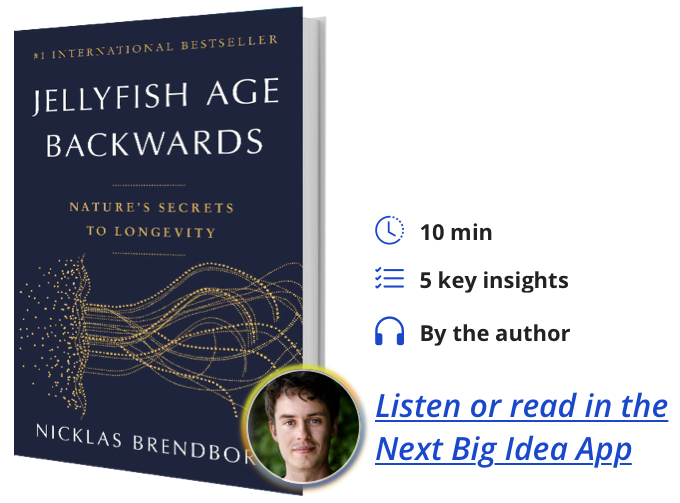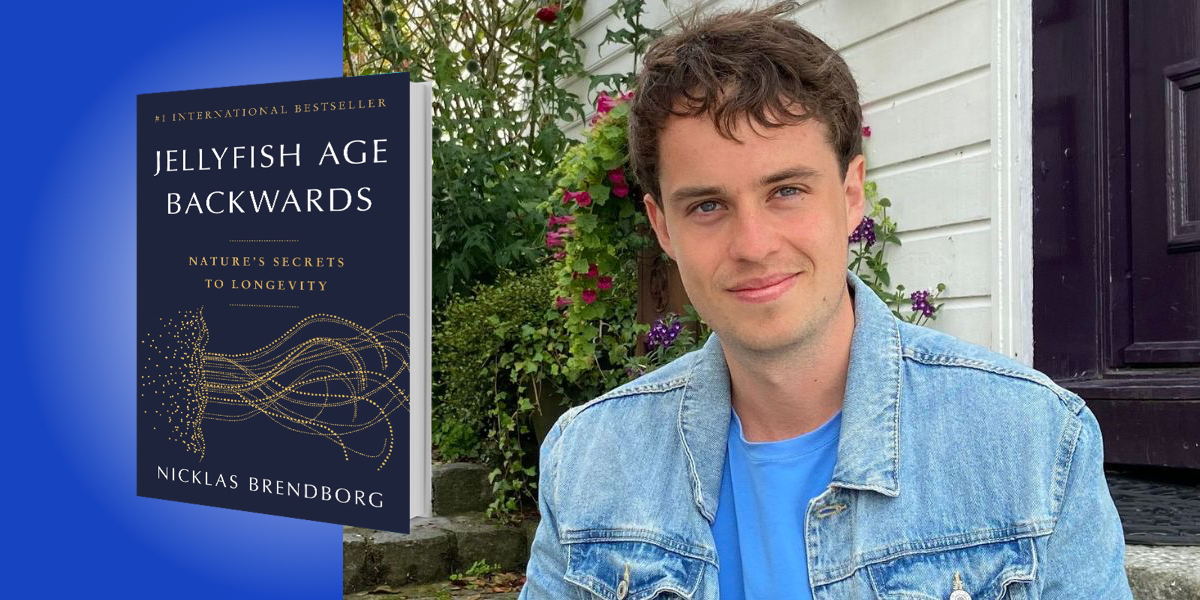Nicklas Brendborg is a PhD student of molecular biology at the University of Copenhagen where he researches aging. He was a featured young scientist at the Novo Nordisk International Talent Program and was awarded the Novo Scholarship.
Below, Nicklas shares 5 key insights from his new book, Jellyfish Age Backwards: Nature’s Secrets to Longevity. Listen to the audio version—read by Nicklas himself—in the Next Big Idea App.

1. Aging is the root cause of all our worst diseases.
Today, the top causes of death are cancers, cardiovascular diseases, and dementia. If you dive into the molecular details, there are unique mechanisms involved in each disease. For instance, the reason we get Alzheimer’s disease is different from why we get colon cancer or heart attacks. But if we take a step back, the root cause of all these diseases is the same. The root cause is aging.
Someone like me, who’s 27, won’t develop dementia this year. I have a very low risk of getting cardiovascular diseases, and I’m protected against most cancers. But the older you get, the higher your disease risk. That means that the most sloppy 27-year-old who is overweight, smoking, never exercising, and has a terrible diet will still have a lower risk of cancer than an 80-year-old who does everything right.
This is because the physical decline happening in aging opens the door for diseases. We would kill many birds with one stone if we could target the decline of aging directly. If we could age more slowly, we would not only live longer, but also have a lower risk of disease.
The fight against aging is not necessarily about living as long as possible. It’s about having more good years. Aging scientists usually say that the ultimate goal is to die young as late as possible.
2. Aging is surprisingly variable.
You might think aging is some kind of physical law that all organisms have to abide by, and indeed we see many of the same forms of decline happening in different species, but this decline happens at wildly different speeds.
“There are trees alive today which sprouted before the pyramids were built, making them more than 5,000 years old.”
For instance, a laboratory mouse will age and die in two or three years, while the longest-lived humans have made it past 120 years. But even this pales in comparison to other biological organisms. The longest-lived mammal is a whale called the bowhead whale, and it can live more than 210 years. Being a mammal, it’s one of our close relatives, yet it outlives even the best of us by more than a century. In the grand scheme of things (beyond mammals), there are other biological organisms that can live way longer than even the bowhead whale—like the Greenland shark, which can live more than 400 years, or certain mussels, which can live more than 500 years. There are trees alive today which sprouted before the pyramids were built, making them more than 5,000 years old.
Even if nature has some kind of limit to how long a biological organism can live, we humans are far, far away from it. That means we could learn from these organisms how to age more slowly.
3. There are widely different patterns of aging in nature.
Aging is not just a gradual process (like it is for us) for all species. For instance, some salmon and octopus basically won’t age throughout most of their life and then experience the entire aging process all at once at the very end. That would be like a human staying in the physical shape of a 25-year-old until turning 90, and then going from that peak condition to the physical condition of a 90-year-old within two months, and then dying from old age.
There are also species, like lobster, that don’t age at all. With time, lobsters get larger, more fertile, and less likely to die—meaning that the strongest and most fertile lobsters are the oldest ones.
“There are also species, like lobster, that don’t age at all.”
Some animals even age backwards. There is a jellyfish species called Turritopsis, which is around the size of a fingernail, and basically just swims around eating plankton. With the naked eye, it’s not incredibly exciting. But if you stress it, for instance by changing the water temperature or by starving it, then it can go from its adult stage back to something called the polyp stage. That would be akin to a butterfly turning into a caterpillar again. From there, the jellyfish can grow up again. If you stress it again, it will rejuvenate itself again and grow up once more, and so on and so on.
No one has found a limit to this trick. It’s quite possible that this jellyfish is the Holy Grail of aging research: an animal which is biologically immortal.
4. What you can do in practice right now to slow aging.
Stress is not always bad. You might think you need to treat your body very gently if you want to live long. But biological organisms are more complicated than that because we experience hormesis—gaining strength through adversity.
Most people know exercise is healthy, but a lot of people think that this is due to something happening while you are doing it. For instance, while you’re running your heart rate is elevated, your blood pressure is high, your muscles and bones are getting damaged, and your lungs are also stressed from drawing in lots of air. The reason your mind is telling you to stop when you run is because you’re hurting yourself. But then magic happens after the run because the body sees the damage as a signal saying you need to get stronger. So your body starts processes involved with repair and strengthening, making you more resilient.
“Laboratory worms will live longer if they’re exposed to a little weed killer or heavy metals.”
This phenomenon isn’t isolated to exercise. You can find it in connection with all sorts of stressors. For instance, laboratory worms will live longer if they’re exposed to a little weed killer or heavy metals. The same is true if you expose mice to low levels of radiation.
To be perfectly clear, don’t go experimenting with weed killer or radiation. But I do have a bunch of ways to use beneficial stressors in my book, such as sauna use, winter swimming, fasting, and blood donations. We gain strength through adversity.
5. In addition to classic advice, a bit of weird advice.
One piece of advice that readers have been especially interested in is why I recommend flossing for a long life. It turns out there’s this weird connection between mouth bacteria and many age-related diseases. For instance, there’s a certain mouth bacterium that keeps getting found inside the brains of people who died from Alzheimer’s disease, but not in the brains of people who died from other causes. This bacterium has also been found inside the clots that caused a heart attack, and other mouth bacteria pops up in diseases like colon cancer and pancreas cancer. We also know there’s a condition called periodontitis, where mouth bacteria start growing out of control. This condition is associated with an increased risk of all these diseases.
I’m not saying mouth bacteria are the root cause of these diseases, but it is very possible that they contribute. Luckily, there is an easy way to avoid this by simply keeping mouth bacteria in check. Do that by removing the food source left in your mouth after eating. Flossing might decrease your risk of a lot of nasty diseases.
To listen to the audio version read by author Nicklas Brendborg, download the Next Big Idea App today:





























